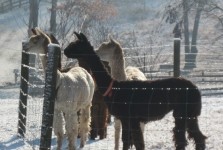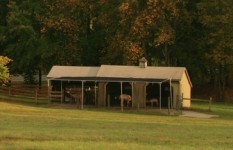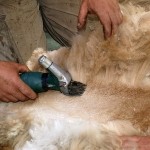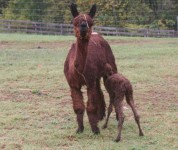Are alpaca really easy to take care of?
Yes, they really are. Many people that have never lived on a farm, or had livestock are finding that alpaca are the perfect animal to have. They are small and non-aggressive. Alpaca are very smart, and once they know the routine, and what you want, they are very cooperative.
They are gentle and easy to handle. Clean-up is easy since alpacas deposit droppings in only a few places in the paddock. Alpaca are also a clean animal, and use communal dung piles. This makes clean up much easier. Their waist, called beans, are virtually odorless and about the size of navy beans. Children often joke that they look more like chocolate covered raisins than beans. A small rake and shovel make clean up quick and easy.
Regular care include: trimming their toenails every couple of months, shearing them once a year, and giving them regular worming and vaccinations. top
Alpaca are very gentle and inquisitive. They prefer to be with their own kind, and as a prey animal can be a bit nervous around strange people. However, the more you work with your alpaca they more accustom they will become to you. Most will recognize their feed buckets, and will come eagerly when they seen them.
My children and grandchildren have been feeding our alpaca from their hand for years. A shady tree in the alpaca pasture makes a great place to relax and read a book. The gentle humming of the alpaca make a wonderful restful setting. I can testify that if you snooze off it is not unusual to wake up with a number of alpaca noses in your face. top
Why is there so much interest in alpacas?
Alpaca are raised mainly for their fiber. Soft as cashmere and warmer, lighter and stronger than wool, it comes in more colors than any other fiber producing animal (approximately 22 basic colors with many variations and blends). Spinners and weavers around the world now enjoy this cashmere-like fleece, once reserved for Incan royalty.
The alpaca textile industry is new and growing rapidly. Alpaca fiber is sold several ways. Hand-spinners and fiber artists buy raw fleece. Knitters often purchase alpaca yarn. Fiber Cooperatives Mills collect alpaca fiber and process it on behalf of the producer.
Along with providing an excellent investment opportunity, alpaca have also give countless people the opportunity to start a more laid back and relaxing lifestyle. top
No. Alpaca do not bite or butt. I never recommend approaching any animal from behind. This may startle them, and in fright they will do something uncharacteristic. (Remember that alpacas are a prey animal.) Children seem to have a special love for alpacas and crias, and this seems to be mutual. If alpacas do not want to handle they will simply quietly move away as they are approached. top
Adult alpaca average between 32″ to 39″ tall at the withers, shoulder, and weigh about between 100 – 200 pounds. top
The average live span of an alpaca is around 20 years. top
Are there different kinds of alpaca?
There are two types of alpacas – the Huacaya (wah-ki-ah) and the Suri (sir-e). The suri’s fiber grows quite long and forms silky, pencil-like locks. The huacaya has a shorter, dense, crimpy fleece, giving it a very woolly appearance.
How mach acreage does it take to raise alpacas?
Depending on the quality of the pasture you have between five and ten alpaca per acre. Alpaca are gentle on the land, and an excellent environmentally friendly livestock. Alpaca have soft padded feet that leave pasture undamaged and usable for years. top
Can I start out with one alpaca?
No, alpaca need to have a herd to be happy. It can be a small herd of two, but this is the minimum. If you want to start slowly try purchasing one female and a gelding, or even two geldings. top
Alpacas are a modified ruminant with a three-compartment stomach. It converts grass and hay to energy very efficiently, eating less than other farm animals. Alpaca do best on grass and hay, and only approximately 2 pounds per 125 pounds of body weight per day. A, 60-pound bale of hay can feed a group of 20 alpacas for one day. Additionally, all alpaca require free-choice minerals supplements and plenty of fresh drinking water. top
Do I need a barn to have alpacas?
Alpaca are a very hardy animal from the Andes Mountains in South America. During the winter they have a good heavy fleece to keep them warm and dry. Many alpaca breeders in Virginia have open three sided shelters. This allows the alpaca to come and go as they please. While providing shelter from the wind, rain and snow if they desire it. A good layer of gravel allows liquids to drain away, and is a good option for the floor. top
Alpaca are not known for challenging fences, and they usually do not wonder far if they get out. However, a good fence is vitally important to keep alpaca safe from predators. Even neighborhood dog can be dangerous if they decide they like to chase alpaca.
Four foot tall woven wire fencing with 2″ x 4″ openings work well. Field fencing is also a good option, and can often be purchase more economically. The openings at the top are larger and become smaller as you get closer to the ground. Many people use a combination of fencing for the best protection of their alpaca. For example a strand of barbed wire run along the outside of the fence will help keep dogs, coyotes and other predators from digging under the fence. While a good strand of electric tape around the top will help prevent predators from going over the top. top
How do we get their fleece off them?
Alpacas produce one of the world’s finest and most luxurious natural fibers. It is clipped from the animal without causing it injury once a year in a process called shearing. When you purchase your alpaca ask the breeder for the name of a good shearer. The cost is around $25.00 per animal, and does not take long. The amount of fleece you get from each animal vary from 3 to 10 pounds. top
For traveling short distances many people use vans, mini vans, blazers and even station wagons. An old piece of carpet or heavy canvas will help protect the vehicle from damage. Once moving the majority of alpaca will quietly cush, lay down. We have transported our alpaca for up to 5 hours in the back of our blazer and mini van. For long distances a professional transporters with livestock trailers may be required. top
A female alpaca can start breeding between 18 and 24 months. The gestation period is 11 ½ months, yes, that is close to a year! Cria, baby alpaca, weigh between 15 – 21 pounds at birth, and are most often up and nursing within an hour. They are weaned around 6 months of age. Female will rebred between 2 and 4 weeks after giving birth, and can have a cria a year through their reproductive life. However, it is wise to give females breeding breaks.
Males become fertile between the age of 2 and 3 years old. A male that is used for breeding is often called a herdsire or macho. top
Prices vary depending on the breeding quality of the animal. You can purchase a beautiful gelding or fiber alpaca for a $500. However, a female that has a proven history of having quality cria will average $5,000 and $12,000. While a proven herdsire can cost $5,000 up. top
Alpaca first began being imported to the United States in 1985, and the importation is now closed. Yes, alpacas can still come into the United States, but they can no longer be registered. A female alpaca can only have one cria a year, so herd growth is slow. Over the last few years the demand for alpacas has increased, while the supply has remained low and slow growing. This makes good quality breeding alpaca in high demand. top
If I want to consider purchasing an alpaca what should I do?
First, it is important not to jump in to any major life change without serious consideration. Visit the AOBA website and request some of the free alpaca magazines they offer. The Internet is another source of information. I hope that our website will provide you with first class educational resources and practical advise about alpacas.
Next, visit some farms and talk to as many breeders as possible. As you read write down your questions, and then ask them. Ask if you can help with the Saturday morning chores, spring shearing, or trimming nails. Be sure you like the hands on of alpacas, and not just the TV ad ‘glamour’.
Attend some alpaca shows if you have the opportunity. This will give you the perfect opportunity to see some high quality alpaca. Conformation is an important part of raising alpacas, and there is nothing like a show to help you learn some of the basics.
Finally, if you do decide to purchase some alpaca choose a breeder that you feel you can trust. At Suri Downs Farm we are willing to work with new breeders, and to be your mentor. top
You may contact me is you have any questions amandabrand@suridownsfarm.com.



